By her late 30s, Lorna Kleidman was spending four-hour days at the gym, hitting back-to-back-to back fitness classes, and trudging along on the treadmill in between. And then at age 39, something finally clicked. Fitness could be easy, fun, and fulfilling. All she needed was a kettlebell.
Kleidman quickly overhauled her entire routine and landed a coach who would eventually prepare her to compete at the highest level imaginable. She went on to win all 10 national and international competitions she entered, including three world championships, and a world record in 2011. Today, Kleidman is determined to help others find that same strength, confidence, and success through her new beginner-friendly kettlebell program KettleX. To start the New Year off right, Greatist’s fitness editor swung in on the kettlebell champ to talk training, transformations, and why it never hurts to try something new. And don’t miss Kleidman’s exclusive KettleX workout included below!
You call yourself a late-life athlete. At what age did you begin to get into fitness and sports?
I got into the gym scene in my late 20s. But it wasn’t until my 30s that I really set out to reshape my body. I didn’t just want to be skinny. I wanted be strong and healthy, and a head-turner. So I started taking just about every class they offered at the gym—two classes a day [during the week], and four classes on Saturday. And in between them I would go on the treadmill jogging. I thought that was what was required to look great. And then one day over the summer I was jogging outside and I thought to myself, “How in the hell am I going to keep this up when I’m in my 40s and 50s?” I knew there had to be other ways.
So when did you discover kettlebell training?
In 2005, at age 39, I was introduced to kettlebell workouts and I quickly found I didn’t need to work out two hours a day, or even every day. I reduced my time in the gym by more than half and got better results: lean lines, [improved] metabolism, and my butt was lifted and round. I realized you didn’t have to go crazy to look good and stay that way.
I know a lot of people—women in particular—can be intimidated by kettlebells. How do you try to address that?
It’s true. That’s why we’re taking it away from the perception of the old Russian strong man and strong woman tool ... We’re showing people they do make them in lighter weights. I’m not going to put a 35-pound bell in your hand and say, “OK, let me see what you’ve got.” My goal is to show you how to make it fun and easy to learn.
People love working with kettlebells because of the graceful, circular movements. And it’s dynamic. We’re meant to move forward and back, side to side, and in rotation. So when you’re moving a kettlebell in creative ways, like the way I teach it, you’re using all of your body at one time, moving in many different planes of motion in all different dynamic ways. It creates a balanced body. And it creates a beautiful symmetry that many women don’t have because they often work more on their lower body rather than their back, arms, or shoulders—so they might have semi-toned legs but their posture [can suffer].
Are there any common mistakes you see beginners make when they’re first starting out?
I see very few problems with beginners using the kettlebell. The only challenge is: How can you make it better? How can you use it in a more dynamic way? How can you utilize the wonderful resistance tool to not only have fun, but create the body that you want? That’s why I’ve created hundreds of movements—some people have seen before, others are my own creative movements (see sample workout below!).
How many days per week do you train, and what would you recommend for others?
Now that I’m no longer competing, I train about four days a week. Once in a while I might throw in a barbell, but it’s mostly kettlebells. I do my own workout and do some of the competition lifts still, but the key is always mixing it up. Heavier weights, lighter weights, different movements, different complexes, timed drills—it’s always different.
And do you cross train?
I do yoga about once a week, but I don’t need a lot of extra cardio in addition to kettlebells because the bell provides resistance and cardio at the same time.
You recommend everyone starts with kettlebell fitness, but beyond that, what does competition entail?
Competition requires tremendous skill, aerobic capacity, endurance, and mental focus. It’s a 10-minute performance, so you have 10 minutes to put up as many reps as you can without putting the bell down, and you have only one opportunity to change hands. So if you start on your right side, you can only change once to your left …
I started with snatch. But I have also done the other two lifts: the jerk and the long cycle. These are the three basic lifts in competition, and you prepare for one. Think of it like a runner who prepares for a certain meter dash.
So it’s not all about weight. But… How heavy are the kettlebells you train with?
In international competition the minimum weight for women is 16 kg (or 35 lbs). The men, depending on their age, lift 53 lbs (or 70 lbs). The good news is, here in America, in national competitions you can compete using much lighter weight to start out with. So for example the 12 kg (or 26 lbs) as a woman. And that’s a really good thing for the sport; many people are getting into it because of that.
I started out with 16 kg, and I’ve worked with up to 20 kg. But now that I reached all my goals, including the world record, my sole focus is making kettlebells accessible and fun for everybody.
Lorna Kleidman’s Kettlebell Workout
Ready to try out some of Lorna’s favorite kettlebell movements? Follow along for her beginner-friendly kettlebell workout, detailed below. For each exercise, complete three sets of the suggested reps with a maximum of 60 seconds rest in between. Women use a 15 lb kettlebell, and men use a 20 lb kettlebell to start. Advance to a heavier weight when movements become easy.
2. Lateral Lunge, Open Arm Begin with kettlebell in the right “home position,” with the body of the bell resting between your arm bones, hand relaxed at your chest. Step your left leg to a lateral lunge, keeping the right leg straight and sending the butt back behind you (while the spine stays long). Using the floor, push your left leg down and away to stand up, as you bring the bell back to “home.” Complete 10 reps on each side.
4. Backward Step, Pass Hold the right corner of the bell in your right hand. Step your right leg back, bending both knees and pass the bell under right leg to your left hand. Stand. Repeat on left side, stepping back with left leg. Alternate for a total of 10 reps on each side.
Get bored easily, or want to up the intensity just a bit? Try performing the above moves in supersets (so any combination of two movements back-to-back) with 60 seconds rest in between sets. Or, perform them as a circuit, completing moves 1-6 in order, three sets through, with 60 seconds rest in between sets. For an added challenge, try to reduce rest periods by 5-10 seconds each week, Kleidman suggests.
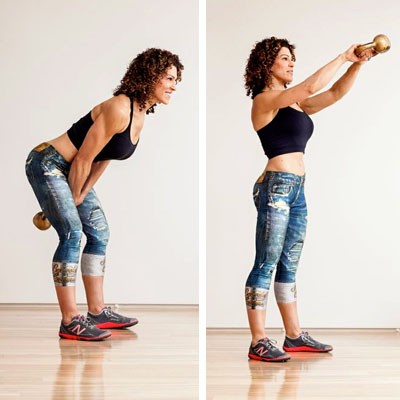
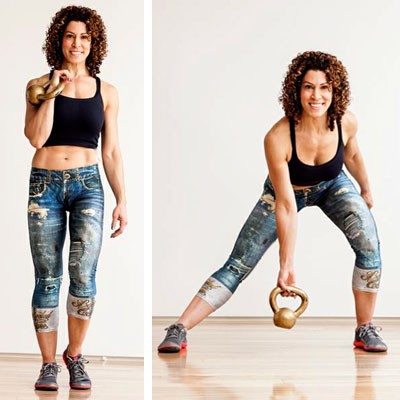
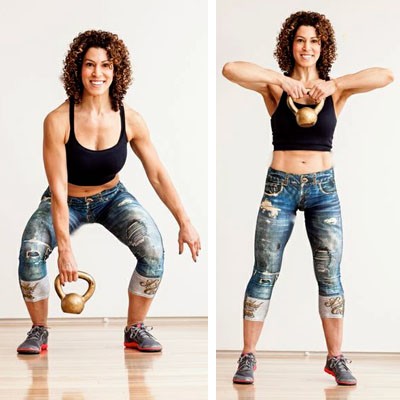
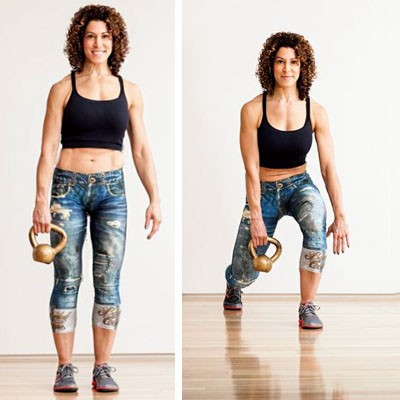
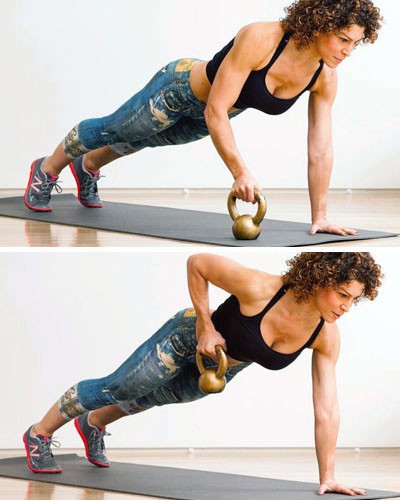

Комментариев нет:
Отправить комментарий